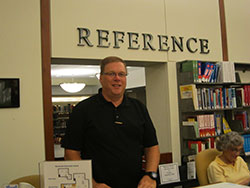Guggenheim Library Offers Resources Accessible to Students Anywhere
 Many students have heard about the wealth of history behind the University’s Guggenheim Library, but how many are aware of the wealth inside of it? Plenty of students have taken advantage of the free computer and printing and copying access that the library offers, as well they should. However, the University strives to educate its students about the resources offered to assist students in their academic careers.
Many students have heard about the wealth of history behind the University’s Guggenheim Library, but how many are aware of the wealth inside of it? Plenty of students have taken advantage of the free computer and printing and copying access that the library offers, as well they should. However, the University strives to educate its students about the resources offered to assist students in their academic careers.
“We have almost 300,000 books,” said Assistant Librarian and Coordinator of Reference Services and Special Collections, George Germek, “and we have thousands and thousands of online databases, limitless really, too many to mention because they grow every day.” These hundreds of thousands of online resources are products of the technological advances made in the 21st century. However, other old fashioned resources have not become outdated, and are not suspected to in the near future.
“We also have printed periodicals, too,” said Germek. “Certain people in the humanities—English, history, people of that background—will still use print extensively.”
Though printed resources are still widely used among students and faculty, certain areas of study are really benefitting from the online research aids available to them, according to Germek.
“Social studies and some of the maths in this world, they use a lot of digital depositories, but not everyone.”
The University tries to ensure that all students are aware of these resources offered to them and introduce them to the people on campus who are there to help. Many classes require sources from academic journals for papers and assignments.
“Students don’t know about it until they come in and learn,” said Germek. “We have classes that will basically introduce students to how to do research in the library, and they come in during the first year. Teachers usually bring them in and organize a class, so we teach a bunch of those classes, probably about 70 or 80 of them a semester.”
Sophomore at the University, Mike Burke says he first took the library research course for an information technology class one year ago.
“The University has a vast collection of accredited articles, papers, and discussions on a variety of topics, all easily found by typing in a few key words,” he said. “The resource has an extremely easy user interface and allows for quick searches to be made and refined.”
Sophomore Shannon Yingst agrees.
“The library research class was an amazing help for research papers. All of the different ways to search for documents were unknown to me before that class,” she said.
After students first learn about how to use the library resources, they often come back. Even if they do not physically return to the library, students can take advantage of the tools offered there from their own computer outside of the library and even off campus.
“They all [online databases] can be accessed with students’ usernames and passwords,” explains Germek. He also reveals some of the most popular and commonly used online databases.
“When students do [research] online, they use EBSCO’s Academic Search Complete and they use Pro Quest Central. Those are multi-subject databases, they search everything. From newspaper articles to TV shows to real academic research, it’s like the kitchen sink. It has everything. That’s generally where new researchers begin.”
More experienced researchers working on subjects that are less broad will go on to explore some of the more refined databases that the University library offers.
“As they go on,” said Germek, “they do stuff in journal locator, where they look for specific journals. Like if they have to write a paper on Shakespeare, they really wouldn’t want to use the multi-subject database because that can include too much and overwhelm them. So they would come and maybe look for a Shakespeare studies journal or database.”
If this plethora of books and databases does overwhelm students, the librarians on staff are more than willing to help and send them in the right direction according to their research subjects. The library is fully staffed every day, including weekends, allowing students as well as outside residents to find assistance and ask questions. Librarians can also be contacted via email or telephone, though most of their encounters with students are in person.
“We’re really big on face to face contact, we’re kind of relaxed and casual that way and people don’t mind coming up to us,” Germek said.
As for those students on strict schedules due to class, work, sports or other activities, the library hours are flexible. Every Monday through Thursday, while classes are in session, the library is open from nine in the morning until midnight. Reference librarians will be on staff to help students until at least two hours prior to closing. The hours change, however, on weekends and near midterms and final exams.
“Fridays the library closes at six, Saturdays it’s open from nine to five, and Sundays it’s open from noon to midnight,” said Germek. “And we extend those hours when exams come up.”
Though the Guggenheim Library is mainly an environment for studying and research, academic work is not the only purpose this building serves.
“There are plenty of people that even just come here to read in private, some use the databases, some cruise the internet, some are on Facebook, some are doing real serious literary research, it’s a wide variety,” said Germek. “Then we have people from the neighborhood who come in and do Google searching and so on and so forth as well.”
One of the newest areas of research in the campus library is the ever growing rare books collection consisting of many original manuscripts and historical texts. Also continuing to grow are the online databases. The library staff decides what online resources to add to their collection by seeing what students are finding most helpful.
“We monitor their usage and we buy new ones that we think students would use, so we are getting new resources all the time,” Germek explained. “And then we use a thing called a Lib Guide. What the Lib Guide does is, if you want to take a class on communication, these are all individual, customized electronic research guides that students use in order to find books, articles, anything.” These guides are custom designed to any class that a professor wants.
Plenty of computer space exists for students wishing to use the resources on campus. Computer availability has never been an issue. Students who cannot find a desktop are able to sign out a lap -top computer to use anywhere in the library. Germek said that the busiest hours of the day are between eleven in the morning and three or four in the afternoon, and then again around seven during exam times.
The University’s library website also has an award winning plagiarism tutorial to teach students what qualifies as plagiarism and how to avoid it by citing materials properly. Some classes also require students to take the tutorial and print out the certificate of completion provided at the end.
A multitude of students from diverse majors and areas of study take full advantage of the resources offered by the University’s library. Most, however, take for granted what they have access to, especially through the online databases.
“Students could never get those articles and documents in a typical Google search,” states Germek. “If they’re not logged into our Monmouth system you’re never going to see all those articles. Those articles are proprietary, they’re owned by publishing houses or electronic firms, and when you pay for your student tuition it pays for access to these databases.
PHOTO COURTESY of Casey Wolfe



